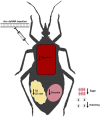Deficiency of Acetyl-CoA Carboxylase Impairs Digestion, Lipid Synthesis, and Reproduction in the Kissing Bug Rhodnius prolixus
- PMID: 35936892
- PMCID: PMC9353303
- DOI: 10.3389/fphys.2022.934667
Deficiency of Acetyl-CoA Carboxylase Impairs Digestion, Lipid Synthesis, and Reproduction in the Kissing Bug Rhodnius prolixus
Abstract
Rhodnius prolixus is a hematophagous insect, vector of Chagas disease. After feeding, as blood is slowly digested, amino acids are used as substrates to fuel lipid synthesis, and adult females accumulate lipids in the fat body and produce eggs. In order to evaluate the importance of de novo fatty acid synthesis for this insect metabolism, we generated acetyl-CoA carboxylase (ACC) deficient insects. The knockdown (AccKD) females had delayed blood digestion and a shorter lifespan. Their fat bodies showed reduced de novo lipogenesis activity, did not accumulate triacylglycerol during the days after blood meal, and had smaller lipid droplets. At 10 days after feeding, there was a general decrease in the amounts of neutral lipids and phospholipids in the fat body. In the hemolymph, no difference was observed in lipid composition at 5 days after blood meal, but at day ten, there was an increase in hydrocarbon content and a decrease in phospholipids. Total protein concentration and amino acid composition were not affected. The AccKD females laid 60% fewer eggs than the control ones, and only 7% hatched (89% for control), although their total protein and triacylglycerol contents were not different. Scanning electron microscopy of the egg surface showed that chorion (eggshell) from the eggs laid by the AccKD insects had an altered ultrastructural pattern when compared to control ones. These results show that ACC has a central role in R. prolixus nutrient homeostasis, and its appropriate activity is important to digestion, lipid synthesis and storage, and reproductive success.
Keywords: Rhodnius prolixus; acetyl-CoA carboxylase (ACC); de novo lipogenesis; fat body; oogenesis.
Copyright © 2022 Moraes, Braz, Santos-Araujo, Oliveira, Bomfim, Ramos and Gondim.
Conflict of interest statement
The authors declare that the research was conducted in the absence of any commercial or financial relationships that could be construed as a potential conflict of interest.
Figures








Similar articles
-
Blood meal drives de novo lipogenesis in the fat body of Rhodnius prolixus.Insect Biochem Mol Biol. 2021 Jun;133:103511. doi: 10.1016/j.ibmb.2020.103511. Epub 2020 Dec 2. Insect Biochem Mol Biol. 2021. PMID: 33278628
-
Insulin receptor deficiency reduces lipid synthesis and reproductive function in the insect Rhodnius prolixus.Biochim Biophys Acta Mol Cell Biol Lipids. 2021 Feb;1866(2):158851. doi: 10.1016/j.bbalip.2020.158851. Epub 2020 Nov 4. Biochim Biophys Acta Mol Cell Biol Lipids. 2021. PMID: 33160077
-
Deficiency of Brummer lipase disturbs lipid mobilization and locomotion, and impairs reproduction due to defects in the eggshell ultrastructure in the insect vector Rhodnius prolixus.Biochim Biophys Acta Mol Cell Biol Lipids. 2024 Mar;1869(2):159442. doi: 10.1016/j.bbalip.2023.159442. Epub 2023 Nov 30. Biochim Biophys Acta Mol Cell Biol Lipids. 2024. PMID: 38042331
-
The hormonal and neural control of egg production in the historically important model insect, Rhodnius prolixus: A review, with new insights in this post-genomic era.Gen Comp Endocrinol. 2022 Jun 1;321-322:114030. doi: 10.1016/j.ygcen.2022.114030. Epub 2022 Mar 19. Gen Comp Endocrinol. 2022. PMID: 35317995 Review.
-
Lipid metabolism in insect disease vectors.Insect Biochem Mol Biol. 2018 Oct;101:108-123. doi: 10.1016/j.ibmb.2018.08.005. Epub 2018 Aug 29. Insect Biochem Mol Biol. 2018. PMID: 30171905 Review.
Cited by
-
Silencing of the 20S proteasomal subunit-α6 triggers full oogenesis arrest and increased mRNA levels of the selective autophagy adaptor protein p62/SQSTM1 in the ovary of the vector Rhodnius prolixus.PLoS Negl Trop Dis. 2023 Jun 2;17(6):e0011380. doi: 10.1371/journal.pntd.0011380. eCollection 2023 Jun. PLoS Negl Trop Dis. 2023. PMID: 37267415 Free PMC article.
-
Metabolic and transcriptional regulation of reproductive diapause in Arma chinensis.iScience. 2025 Jan 6;28(3):111761. doi: 10.1016/j.isci.2025.111761. eCollection 2025 Mar 21. iScience. 2025. PMID: 40124477 Free PMC article.
-
Energy Reserve Allocation in the Trade-Off between Migration and Reproduction in Fall Armyworm.Insects. 2024 Oct 16;15(10):809. doi: 10.3390/insects15100809. Insects. 2024. PMID: 39452385 Free PMC article.
-
Feeding Asian honeybee queens with European honeybee royal jelly alters body color and expression of related coding and non-coding RNAs.Front Physiol. 2023 Jan 26;14:1073625. doi: 10.3389/fphys.2023.1073625. eCollection 2023. Front Physiol. 2023. PMID: 36776963 Free PMC article.
-
Knockdown of Sec16 causes early lethality and defective deposition of the protein Rp30 in the eggshell of the vector Rhodnius prolixus.Front Cell Dev Biol. 2024 Apr 22;12:1332894. doi: 10.3389/fcell.2024.1332894. eCollection 2024. Front Cell Dev Biol. 2024. PMID: 38711619 Free PMC article.
References
-
- Alabaster A., Isoe J., Zhou G., Lee A., Murphy A., Day W. A., et al. (2011). Deficiencies in Acetyl-CoA Carboxylase and Fatty Acid Synthase 1 Differentially Affect Eggshell Formation and Blood Meal Digestion in Aedes aegypti . Insect Biochem. Mol. Biol. 41, 946–955. 10.1016/j.ibmb.2011.09.004 - DOI - PMC - PubMed
-
- Alves-Bezerra M., Ramos I. B., De Paula I. F., Maya-Monteiro C. M., Klett E. L., Coleman R. A., et al. (2017). Deficiency of Glycerol-3-Phosphate Acyltransferase 1 Decreases Triacylglycerol Storage and Induces Fatty Acid Oxidation in Insect Fat Body. Biochimica Biophysica Acta (BBA) - Mol. Cell Biol. Lipids 1862, 324–336. 10.1016/j.bbalip.2016.12.004 - DOI - PMC - PubMed
-
- Arêdes D. S., De Paula I. F., Santos-Araujo S., Gondim K. C. (2022). Silencing of Mitochondrial Trifunctional Protein A Subunit (HADHA) Increases Lipid Stores, and Reduces Oviposition and Flight Capacity in the Vector Insect Rhodnius prolixus . Front. Insect Sci. 2, 885172. 10.3389/finsc.2022.885172 - DOI - PMC - PubMed
LinkOut - more resources
Full Text Sources

